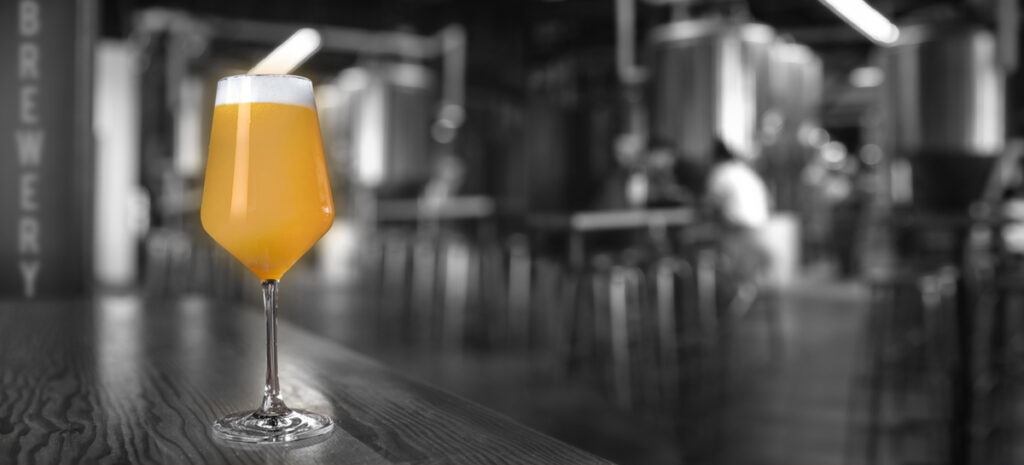Protein Haze: How Understanding pH Will Help You Brew Intentionally Unclear Beer

Have you caught the haze craze? Until the last decade, hazy beers tended to show up primarily as mistakes or unfiltered styles like Belgian and German wheats. Yet ever since New England IPAs took top billing as a go-to money maker, it seems the less you can see through your beer the better.
There are many ways to create haze in beer and more ways to avoid it. It is important to understand how to maximize your beer haze formation if that’s what you’re after. In this article we will explore the role pH plays in crafting successfully murky beers.
The Basics: What Is Beer Haze?
The type of turbidity that’s most affected by acidity levels is called non-microbial colloidal haze and being derived mostly from the combination of proteins and polyphenols from grain and hops, it typically plays a small role in the standard flavor and aroma makeup of a hazy beer. Microbial haze, on the other hand, is formed by yeast deposits and bacteria that can create off-flavors.
Colloidal haze is created when the proteins and polyphenols — plant-derived flavonoid compounds like tannins — in the wort or beer join together. “Colloidal” refers to particulate material that doesn’t settle within the medium that contains it and, as such, can’t be easily separated out with a filter or centrifuge. The most direct way to control colloidal haze is by varying either the protein level or polyphenol content. However, maintaining a stable haze in a finished product has also been shown to be impacted by pH.
Protein and Polyphenol Haze
Colloidal haze develops when proteins and polyphenols bind and they form molecules that A) aren’t very water-soluble and B) are big enough to visibly scatter transmitted light in what’s called the Tyndall effect. Though proteins comprise the majority of haze material at 40-75% of the particles, it’s believed that the more reactive polyphenols actually trigger haze formation.
Scientists are still trying to figure out exactly how this relationship works and why pH levels impact the interaction. Ongoing experiments are at least helping predict the outcomes. Although they disagree on the precise number, scientists have found that beer protein haze forms most efficiently at a pH between 4 and 5.5, with maximum haze formation occurring in an inverse relationship between pH and ABV.
Authors of a 2003 Journal of the American Society of Brewing Chemists paper measured maximum haze formation in wort at a pH between 5 and 5.5. A beer with 6% ABV registered the most turbidity between 4.5-5 pH, and at 12% ABV, they found the most haze potential at 4.5.
More recently at a presentation in 2013, Cornell University food science professor emeritus Karl Siebert (one of the authors of the ASBC paper) further clarified to Master Brewers Association of the Americas members that haze formation reaches its peak just above a pH of 4 and significantly weakens as one moves further up or down the scale.
How Does the Science of Haze Formation Work?
Again, there’s a lot here that’s unclear – pun intended. But what’s certain is that haze represents a lack of molecular stability. In order to precipitate out of a liquid, polyphenols have to create a stable network by cross-linking with proteins.
Polyphenols are fairly insoluble in water, particularly at a pH above 5.5. This lends them the propensity to floc together and combine with other large molecules, similar to the alcohol-soluble, water-insoluble proteins in barley called hordeins.
According to Siebert, proteins usually demonstrate the least solubility in water as they near their isoelectric point – the pH of a solution at which the protein’s net charge becomes zero. The isoelectric point for hordein is above 4, as is the pH at which the organic acid that comprises it most greatly precipitates, in combination with polyphenols. That said, Seibert’s 2013 assertion that beer haze forms most robustly at a pH just above 4 should come as no surprise.
Mashing for Haze Formation
While you don’t typically need to manually alter the pH of your mash to encourage haze, you can help it along by using protein-heavy grains like malted oats, malted wheat, and chit malt. Unmalted barley can also help here. Resist the urge to oversparge or to allow the pH of your mash get too high, both of which may lead to astringency. You’re on target if your mash pH registers below 5.4.
Hot Breaks and Haze
During the boil, heat causes the protein and polyphenolic complexes to coagulate and form a hot break. High temperatures and pH help coagulation and hinder haze formation, given that the more the haze-causing materials coagulate into large flocs, the more they precipitate and form trub, which makes them easy to remove in the whirlpool or hop-back. Remember, we want our molecules to form fine flocs so they remain dispersed throughout the liquid. After the boil, it can therefore be advantageous to bring the wort temperature down to 170-180 degrees F before making any hop additions during whirlpool.
Dry-Hopping for Haze Formation and Stability
Dry-hopping is a great way to cultivate haze, and is critical to the process of making a hazy IPA. Hops in their natural form (i.e. not oils), like malts, contribute plenty of polyphenols. By adding hops during fermentation, these materials can avoid getting caught up in the hot break and as well as the cold break that happens when colling the boiling wort back down. You should notice that hop additions in the fermenter can raise the pH, but other than isolating the hop leaf as the likely source of the change, scientists don’t yet know what causes it. Scott Janish, author of The New IPA: A Scientific Guide to Hop Aroma and Flavor, hypothesized in his recent blog post, A Look At pH in Hoppy Beers, that small dry-hop doses as early as day one of fermentation may help with eventual haze stability. The idea being that the usual post-knockout pH (around 5) is ideal for protein-polyphenol interaction.
Clear Data is Key for Keeping Things Unclear
While there are a number of manipulating factors on colloidal haze stability, pH is a consistent influence throughout the brewing process, from mash to fermentation. Even if you measure an appropriate mash pH early on, you may otherwise miss the mark later in the process and lose that hard-earned cloudiness. It can therefore be critical to keep an eye on pH during all steps of the process in order to ensure success.
Free eBook: Leveraging Data-Driven Fermentation Performance Management
Can fermentation management be improved, as a process? This eBook explores, in detail, how fermentation performance data analysis helps elevate product and business outcomes in a modern brewery, whether brewpub, microbrewery or regional craft brewer.
You will learn:
- Day-by-day performance considerations – learned through the extensive examination of real-time fermentation tank data.
- Key recommendations from the Precision Fermentation science team at each major step of fermentation – “Day zero” (i.e. before you pitch your yeast), the first 24 hours, and day two through the end of fermentation.
- Best practices – Activity to watch out for, broken down by each key measurement – Dissolved oxygen, gravity, pH, pressure, internal/external temperature, and conductivity.
- Key findings that can help you solve problems and improve your results.


